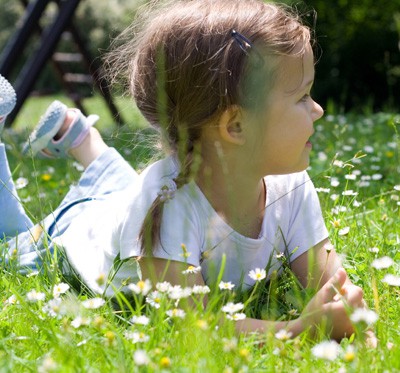Teaching your preschooler or toddler about climate change? That might be a stretch. Helping him to understand the politics and ramifications of GMOs? Prepare for a blank stare. But there’s no reason why young children can’t learn to respect and cherish the environment, simply by developing a relationship with the nature that surrounds them. Younger kids have the capacity to learn about the earth and to begin to cherish it, which will make more complex lessons even more teachable in the future.
- Give children experiences. Allow your children to learn about the texture, weight, and moisture of the soil in your backyard, by making mudpies or planting bulbs if they are a bit older. Let a child feel the bark and leaves of a familiar tree, maybe taking a leaf home to press. Show children how to make a whistling sound with a blade of grass. Craft simple experiences that bond your child to nature.
- Allow for repeated exposure. Children learn well through repeated exposure to concrete experiences. Did your child enjoy whistling with a blade of grass in her hands? Take her outside each afternoon to try it again.
- Incorporate nature into your child’s outdoor play experience. Do you have a swingset in the backyard? Try adding a bird feeder to one of the poles. Attach a windsock or two. And if you and your child enjoy fresh veggies and herbs, build a veggie or herb garden outside, near their play space.
- Demonstrate your own enjoyment of nature. Pointing out trees that you think are beautiful, or encouraging kids to smell flowers that are your favorites will show them that you also love and respect the natural world.
- Model efforts to care for the environment. Explain to your children that you are making efforts to water your lawn and garden only as much as necessary and no more, in order to save water. Allow them to watch you sort the recycling bin, and explain why. Show them that you are turning off lights as you exit a room to save energy. This will encourage them to make similar efforts.
- Allow kids to participate in taking care of the environment.Explain why plastics go in one bin, while paper products go in another, and let them help you sort your recycling. When you leave a room, ask them if they want to flip the light switch off themselves. Remind them not to leave the television on if they’re not watching it, or not to leave the water running if they’re finished washing their hands. Kids will take pride in helping out in small ways.
- Turn to books and movies. Having a hard time getting your kids to embrace the emotional component that comes along with environmental stewardship? Embrace books and movies. The movie, The Lorax, teaches important lessons about taking care of the environment. And Owl Moon by Jane Yolen, On Meadowview Street by Henry Cole, and The Wump World by Bill Peet are all wonderful books to read to young children that will help them make that emotional connection to the natural world.
Is your family making an effort to involve everyone, big and small, in doing their part for the environment? Tell us about your family’s experiences in the comments section!

